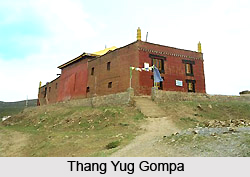 The Thang Yug Gompa is one of the most revered monasteries of Himachal Pradesh. It is located in the districts of Lahaul and Spiti. This monastery is one of the most visited monasteries in the district. It was built in the first half of the 14th century. It is an exemplary specimen of the strong impact of Buddhism on the region. The monastery is associated with the Sa-kya-pa sect of Buddhists and is well known for its historical significance.
The Thang Yug Gompa is one of the most revered monasteries of Himachal Pradesh. It is located in the districts of Lahaul and Spiti. This monastery is one of the most visited monasteries in the district. It was built in the first half of the 14th century. It is an exemplary specimen of the strong impact of Buddhism on the region. The monastery is associated with the Sa-kya-pa sect of Buddhists and is well known for its historical significance.
The Tang Yug Gompa is also recognized for the accomplishment of a group of Buddhist scholars in successfully completing the revision of Tangyur, a Tibetan Scripture consisting of 87 volumes, with their tantric practices. This monastery is situated in Spiti.
History of the Thang Yug Gompa
As stated in the history, a group of eminent Buddhist scholars of Thang Yug Gompa consummated the task of revising the Thangyur. Tangyur is the Tantra treatises. In 87 volumes it constitutes one class of Tibetan scriptures. It has also come to known that in earlier days, the monastery stood at Hikkim, a small town in Lahaul Spiti. Later, the villagers shifted the Thang Yug Monastery to its present site near Comic village. The remains of the old monastery can be still seen in Hikkim. The head lama of the Thang Yug Gumpa usually belongs to Tibet. The Thang Yug Monastery was first built at Hikkim village but after that it was harshly damaged due to an earthquake in 1975; the villagers shifted it to its present location near Comic village.
Architecture of the Thang Yug Gompa
The Thang Yug Gompa is on the other hand not very big in size but follows the basic principles involved in the architecture of Gompas.
Connectivity of the Thang Yug Gompa
The visitors can be reaching to the Thang Yug Gompa through two roads. The first route is used between July and October which is starting from Manali and reaching Kaza through Rohtang Pass. The second one begins from Shimla and goes to Kaza via Kinnaur, which route will be accessible between May to October.





















